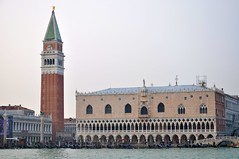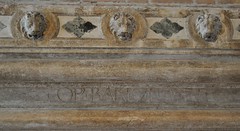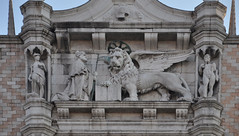The
Doges' Palace was founded by Angelo Partecipazio in 814 approximately, renovated in 977 by the Doge Pietro Orseolo I, and expanded in 1173 by the Doge Sebastiano Ziani.
The first form of the Palazzo Ducale was like a castle, surrounded by walls and towers at the corners. Was destroyed by fire.
In the fourteenth century took to rifabbricarlo, and the work of expansion continued in later ages, including consideration of readjustments that took place after another fire, which occurred in 1483, 1574 and, perhaps the most terrible, in 1577.
The Basegio, Filippo Calendar, Bartolomeo Bon, the Rizzo, Peter Lombard, the Da Ponte, Scarpagnino, Jacopo Sansovino, Alessandro Vittoria and other architects employed the work them in this massive structure.
Even watching from outside perceives the grandeur and the manifest capacity of the Doges that have followed, to prove to their people first, but also to the various rulers who came to visit the city, the power of the medieval city without defensive walls but a
Laguna which has proven its strength over the centuries.
In 1342 construction began on the facade of St. Mark's Basin and was commissioned Filippo Calendario to build on the existing structures, a building that could house the nearly one thousand noble representatives for the assemblies that were to decide the fate of Venice. The same calendar carved reliefs that adorn the edges of the front, dedicating to Adam and Eve on the edge Piazzetta and drunkenness of Noah to the Ponte della Paglia.
It is thought that some capitals of the Ducal Palace of the ground floor, dating back to the fourteenth century, are part of the work performed by Calendar and still in place as when it was proto
Bartolomeo Bon, while part of the capitals were replaced, because degraded, in the nineteenth century and form the Museum of the work which is accessed behind the ticket office of the Palace.
Above the porch of the ground floor and the first floor loggia was erected the wall of the
Sala del Maggior Consiglio room that will accommodate up to 1,700 people on its 1200 square meters, with the impression that the part above the face hard time stand on the empty spaces of the loggia of the first floor and the arcades of the ground floor. Are the numerous columns of the porch of the lodge and to support the wall of the
Hall of the Great Council, columns that have the capitals different from each other, as are several dates in which these columns were placed in their site.
The side facing the
Piazzetta San Marco was built keeping the same trend of the southern part, with arcade on the ground floor and porch on the first floor to make room for the Ballot Hall which houses the large balcony above the effigy of the
Doge Andrea Gritti kneeling opposite the
Lion of St. Mark, in a blaze of pinnacles, statues and decorations.
The main door of access to the
Palazzo Ducale was the one next to the
Basilica di San Marco, called the Gate of the Charter. E 'was commissioned to
Bartolomeo Bon and so signed by the same lintel OP. BARTOLOMEI. Today, however, the audience is made to enter the other entrance on Pier called Gate of Wheat.
In the large courtyard stand the two great Vere borehole cast iron, finely cast in the fifteenth century.
Right behind is the
Scala dei Giganti for the two huge statues of
Jacopo Sansovino adorning the arrival on the summit. This was the place where the Doges swore allegiance to the Republic of Venice in the time of their recruitment in office.
From the balcony of the first floor to access the Apartment Doge climb the famous Golden Staircase by Jacopo Sansovino, cleverly decorated by Alessandro Vittoria with the technique of stucco relief, recently recovered with special studies, trying to get back to execute the decorations as the Romans in its heyday and back in vogue in the late sixteenth century.






